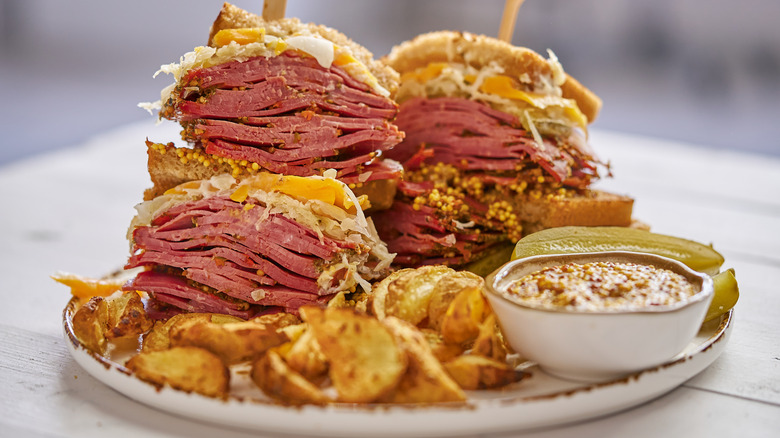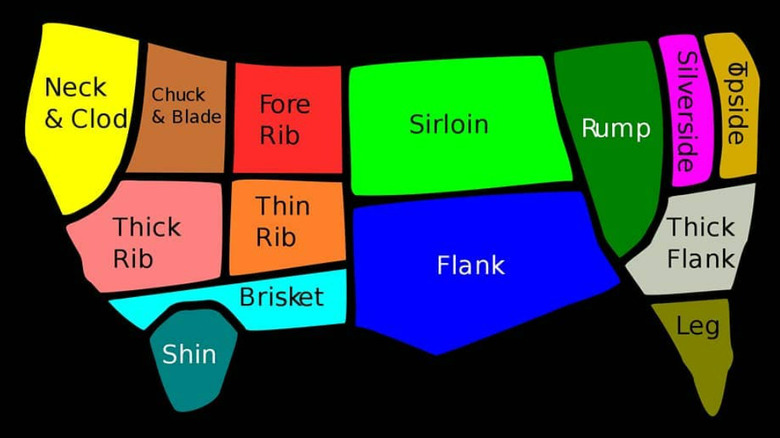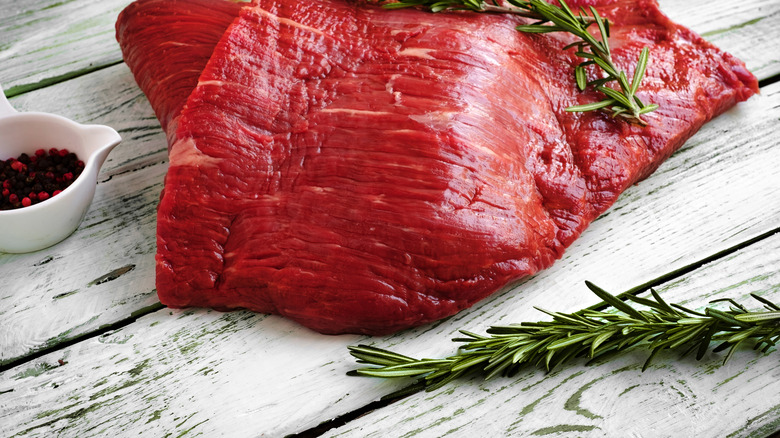Is There A Nutritional Difference Between Pastrami And Corned Beef?
Many see pastrami and corned beef as interchangeable, according to My Jewish Learning. Both are standard deli fare. Both are brined before cooking, a practice born of pre-Industrial Europe's need to store meat without refrigeration, Brent's Deli asserts. Nevertheless, pastrami and corned beef differ in ways that can affect their nutritional values.
First, corned beef is boiled only after the brining salt is rinsed off. Pastrami, by contrast, is dried after brining, then rubbed with additional salt and spices, The New York Times clarifies. This difference could impact sodium content — and does, as we'll see. Second, corned beef, which is boiled or steamed, isn't smoked. Conversely, pastrami is smoked before steaming. While smoking doesn't necessarily alter what goes into pastrami's nutrition labeling, health experts nevertheless take a dim view of smoked meats because they may raise cancer risk, as reported by Cleveland Clinic Health Essentials.
Finally, whereas corned beef is always made from beef brisket, pastrami can be made from various types of meat, notes Leite's Culinaria. Accordingly, pastrami's nutrition information will depend upon the protein and fat content of the meat used. On the other hand, most pastrami in the U.S. is now made from beef brisket, as well. The wrinkle is that brisket is actually two distinct cuts of beef, one of which MasterClass says is significantly richer than the other. That too could make a nutritional difference — assuming pastrami is made from one cut, and corned beef, from the other. That isn't necessarily the case, however.
The flat is leaner than the point
Brisket is a large cut of meat that the butcher carves from the front of the cow, according to MasterClass, as shown above. Most of the brisket is relatively flat, but towards one side, it becomes progressively thicker — like a gently sloping hill, food writer and cookbook author, Melissa Clark, demonstrates in a video she made for The New York Times. The higher elevation, so to speak, is known, interchangeably, as the "point," the "deckle," or the "beef navel plate" (we're going to go with deckle, solely for ease of reference). The rest of the brisket is known as the "flat." The deckle tastes richer than the flat because it is more heavily marbled.
North American Meat Institute maintains that pastrami is, by definition, made from the deckle. Similarly, Cuisine maintains that the flat is the "only" cut to use when making corned beef. In practice, however, both pastrami and corned beef can be made using either the deckle or the flat, according to The Pioneer Woman. Moreover, both pastrami and corned beef are frequently made with both the deckle and the flat, as demonstrated by food bloggers, Real Advice Gal and Dad With A Pan. Often, but not always, that means using the "full packer brisket," which refers to a brisket that has not been cut into its separate deckle and flat components, as The New York Times explains.
The deckle and the flat differ significantly in their protein and fat content
Knowing the nutritional content of either beef pastrami or corned beef requires knowing which cut(s) of brisket were used, and it's not something you can necessarily assume, as The New York Times 1979 discussion regarding Pastrami King suggests. But when you order cooked pastrami or corned beef from a butcher, you can try inquiring as to which cut of beef was used. If you're making your pastrami or corned beef at home, then you'll know which cut(s) you're using.
The deckle, which is the raised portion shown above — and which butchers cut away from the flat portion laterally, contains 304 calories per 3-ounce serving, comprising 72% fat and 26% protein, with 0% carbohydrates, according to Nutrifox. The flat of the brisket, which is what's left after slicing off the more heavily marbled deckle, contains 238 calories per 3-ounce serving, comprising 56% fat, 41% protein, and 0% carbohydrates, also according to Nutrifox.
When corned beef or pastrami is made from one slab of meat, as shown above, the nutritional value of any particular portion you may eat will depend upon which portion of the brisket that it is cut from. In such case, if you get to sample some of both, you'll likely be able to discern the difference fairly readily because meat sliced from the deckle/point will taste richer and have a more unctuous mouthfeel. Meat sliced from the flat may have a drier, stringier texture.
Pastrami and corned beef differ in cholesterol, sodium, and sugar content
Both beef pastrami and corned beef are rich in protein, not to mention all the minerals and other micronutrients found in red meat. Comparing H-E-B's pastrami to its corned beef, for example, shows both offer 14 grams of protein per 2-ounce serving. While neither contains trans fat, and both contain only 1 gram of saturated fat, their respective fat content differs.
At 3 grams of fat per 2-ounce serving, H-E-B pastrami has a slightly higher fat content than H-E-B corned beef, which has 2.5 grams. The pastrami also has slightly more cholesterol (35 mg) than the corned beef (30 mg). These differences could be accounted for by assuming that the pastrami was made with the deckle, and the corned beef, with the flat. However, because H-E-B's nutrition information does not specify the cut used in either case, this cannot be confirmed.
Additionally, as you might have guessed from the discussion above, the pastrami is higher in sodium (630 mg), than the corned beef (490). This would appear consistent with corned beef's being rinsed/soaked before cooking, which The New York Times points out may remove the salt. Pastrami, by contrast, is not rinsed; in fact, its dry rub may add salt. It may also add sugar, per Amazing Ribs. In fact, the other big nutritional difference between these two H-E-B products is that the corned beef contains no sugar, whereas the pastrami has 1 gram of added sugar per 2-ounce serving.


